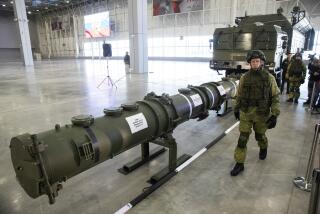Soviet ICBMs Called Secure During Coup : Nuclear arms: But a Moscow expert tells U.S. lawmakers there is greater danger of misuse of tactical weapons designed for battlefields.
- Share via
WASHINGTON — A Soviet expert on nuclear targeting told U.S. lawmakers Tuesday that elaborate safeguards on Soviet weapons ensured that leaders of the failed August coup could not have fired intercontinental strategic missiles at the United States even if they had wanted to.
But the Soviet Union’s 15,000 smaller, tactical nuclear weapons, which are designed for battlefield use, are subject to fewer controls, said Gennady A. Pavlov. They also are more easily transportable than the bigger strategic weapons and have fewer mechanical and electronic locks to prevent accidental or illegal use, he said.
“These weapons pose a greater security threat no matter how redundant and strict the safeguards,” said Pavlov, now an official of the Soviet Academy of Sciences. “Seizure (by terrorists or others) is always possible, and so is the possibility of unauthorized use.”
Pavlov, who has 30 years of experience in Soviet nuclear systems and whose academy is advising the transitional central government in Moscow on the issue, discussed the Soviet arsenal in testimony before a Senate Foreign Relations subcommittee.
Sen. Joseph R. Biden Jr. (D-Del.), chairman of the panel, expressed concern that the leaders of two independent-minded republics, Ukraine and Kazakhstan, have challenged the proposed consolidation of all Soviet nuclear weapons within the Russian Federation.
“In a climate that may come to border on anarchy,” said Biden, “we simply cannot afford to assume that all will be well.”
He proposed the creation of a special U.S.-Soviet commission to seek both safer and smaller nuclear arsenals, including drastic cuts in the number of long-range strategic weapons beyond the limits in the newly signed strategic arms reduction treaty. And he endorsed Russian proposals to eliminate all tactical weapons, which he said have “lost their rationale.”
Concern about the security of Soviet nuclear weapons reached a high point in response to reports that leaders of the attempted putsch against Soviet President Mikhail S. Gorbachev had seized his top-secret instructions on how to order strategic weapons to be fired. In the United States, that material is kept in a briefcase called the “football” and always remains close to the President.
Soviet safeguards are “much more stringent” than those of any other nuclear power, including the United States, according to Bruce G. Blair, a Brookings Institution expert on nuclear command systems. Blair, who appeared with Pavlov before the Biden subcommittee, is collaborating with the Soviet expert on a study comparing the command and control systems of the two nations.
In contrast to the United States, three top Soviet leaders--the president, the minister of defense and the military chief of staff--must authorize use of nuclear weapons except in retaliation for a nuclear attack, in which case launching would be more automatic, Pavlov said. In America, the President alone has that authority.
Another Soviet check on nuclear use is that the individual chiefs of the military services that operate the weapons--the navy, air force, and strategic rocket forces--must approve such an attack, Pavlov said.
“All three of these senior commanders decided among themselves to disobey any launch orders from the coup plotters,” Blair said. Even so, he said he considered it “unsettling” that the crucial obstacle to possible use of nuclear weapons was the opposition of individual military chiefs.
Pavlov and Blair noted two other significant differences in U.S. and Soviet safeguards on strategic weapons:
* Soviet operational missiles contain explosive charges that can be set off if they are launched by accident or error, or if they diverge from their planned course. Except on test flights, U.S. missiles do not carry such explosives.
* All Soviet long-range weapons, both land-based and sea-based, have electronic locks called “permissive action links” that must be released by special codes from the Soviet leadership before they can be fired. U.S. ballistic missiles in submarines have no such locks.
More to Read
Sign up for Essential California
The most important California stories and recommendations in your inbox every morning.
You may occasionally receive promotional content from the Los Angeles Times.










